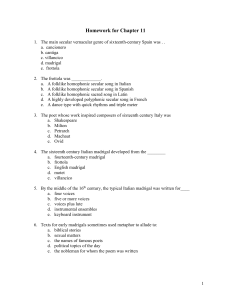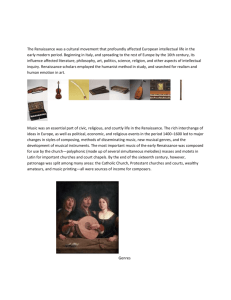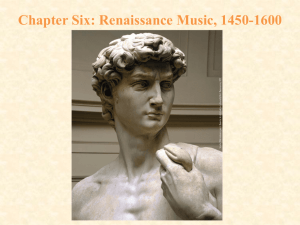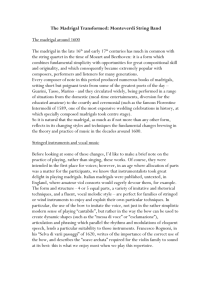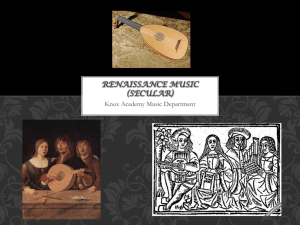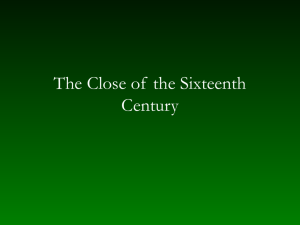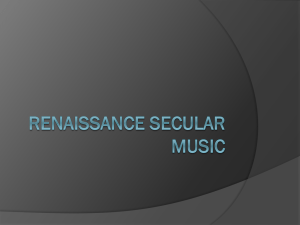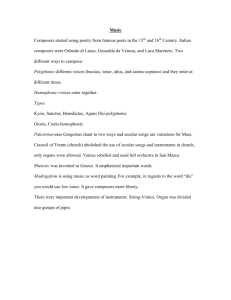Homework for Chapter 11
advertisement
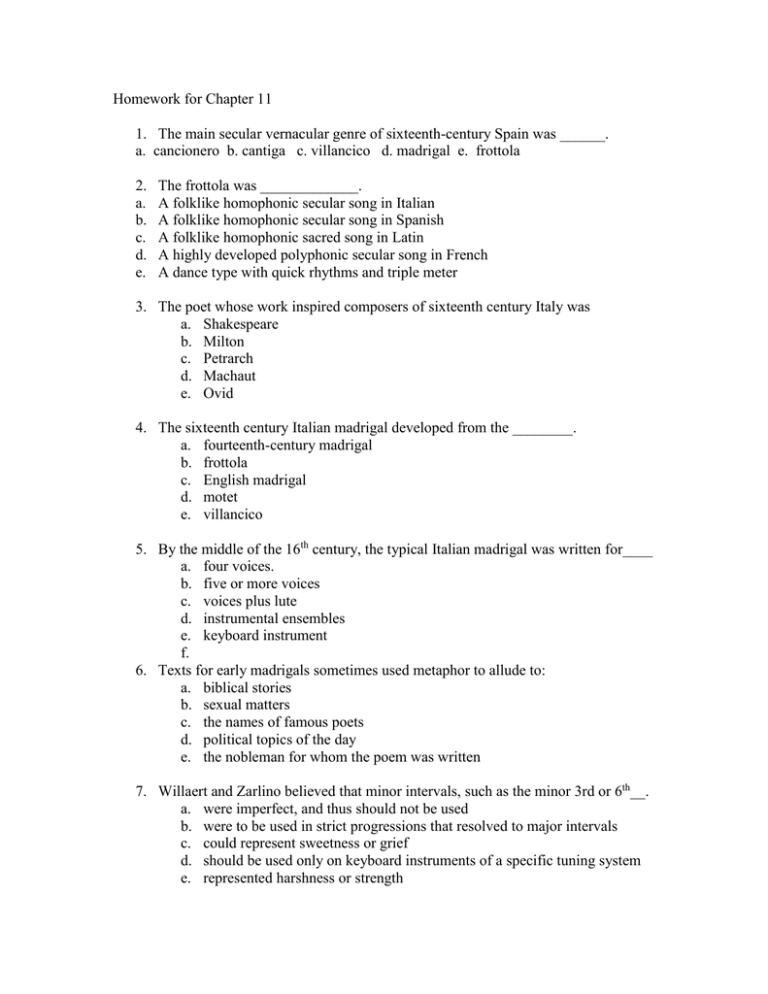
Homework for Chapter 11 1. The main secular vernacular genre of sixteenth-century Spain was ______. a. cancionero b. cantiga c. villancico d. madrigal e. frottola 2. a. b. c. d. e. The frottola was _____________. A folklike homophonic secular song in Italian A folklike homophonic secular song in Spanish A folklike homophonic sacred song in Latin A highly developed polyphonic secular song in French A dance type with quick rhythms and triple meter 3. The poet whose work inspired composers of sixteenth century Italy was a. Shakespeare b. Milton c. Petrarch d. Machaut e. Ovid 4. The sixteenth century Italian madrigal developed from the ________. a. fourteenth-century madrigal b. frottola c. English madrigal d. motet e. villancico 5. By the middle of the 16th century, the typical Italian madrigal was written for____ a. four voices. b. five or more voices c. voices plus lute d. instrumental ensembles e. keyboard instrument f. 6. Texts for early madrigals sometimes used metaphor to allude to: a. biblical stories b. sexual matters c. the names of famous poets d. political topics of the day e. the nobleman for whom the poem was written 7. Willaert and Zarlino believed that minor intervals, such as the minor 3rd or 6th__. a. were imperfect, and thus should not be used b. were to be used in strict progressions that resolved to major intervals c. could represent sweetness or grief d. should be used only on keyboard instruments of a specific tuning system e. represented harshness or strength 8. The leading madrigal composer in the middle of the sixteenth century was_____ a. Pietro Bembo b. Juan del Encina c. Jacques Arcadelt d. Cipriano de Rore e. Carlo Gesualdo 9. Which of the following statements is true of women’s participation in madrigal performance and composition? a. Women were not permitted to compose, sing, or hear madrigals. b. Women were often in the audience when madrigals were performed, but did not perform or composer them. c. Women performed madrigals but none had the musical training to compose them. d. Women both performed and composed madrigals, though not in equal numbers to men. e. Women were the equal of men in the composition and performance of madrigals. 10. The Concerto delle Donne was____. a. a group of women who played viols and recorders in consorts b. a group of women renowned for their singing at noble courts c. an academy that met to discuss ways to set poetry to music d. an orchestra maintained by the Countess of Donne e. a collection of music singable by all-women’s groups 11. Madrigalism can be defined as_______. a. a cadence formula used in madrigals b. the literal depiction of an individual word or phrase c. a poetic device used only in poems destined to become madrigals d. a cadential flourish in the top voice as the other voices hold a chord e. the theory that only in secular music can man’s true spirit be revealed 12. Gesualdo is known for_____. a. writing a treatise on counterpoint based on Willaert’s style b. composing frottole with interesting rhythmic patterns c. being the only member of the pope’s chapel to compose madrigals d. spending most of his career as the maestro di capella at San Marco in Venice e. killing his wife and her lover when he discovered them together in bed. 13.Which composer is known for his/her songs depicting such things as a battle and birds? a. Willaert b. Sermisy c. Casulana d. Janequin e. Sermisy 14. Which composer is know for composing French songs in a style similar to the frottola? a. Willaert b. Sermisy c. Casulana d. Janequin e. Le Jeune 15. The main feature of musique mesuree was______? a. the artificial assignment of long and short values to vowel sounds b. an interest in using meter to express emotion c. extremely polyphonic textures with each voice using a different meter d. the translation of Italian madrigals into the French language. e. extreme chromaticism, used for expressing emotion 16. Hans Sachs is known for what achievement? a. He translated a collection of Italian madrigals into German b. He published a collection of lieder using moveable type c. He was the best known Meistersinger d. He was the first German to serve in the Mantuan court e. He applied techniques of metrical psalm-setting to secular music. 17. Which of the following statements best describes the polyphonic Lied of the mid-16th century a. Audiences lost all interest in it, so composers turned to other genres. b. Composers incorporated concepts developed in the Academy of Poetry and Music. c. English language airs were translated and passed off as original German compositions. d. Although German continued to be the language of the Lied, composers were strongly influenced by the madrigal. e. A revivalist movement among Lutherans banned all secular music, but the elite continued to cultivate it behind closed doors. 18. Musica Transalpina was a collection of______. a. music theory treatises translated from the Greek b. motets that had been turned into madrigals c. German songs that had been translated into English d. Italian madrigals that had been translated into English e. English madrigals that had been translated into Italian 19. The Triumphs of Oriana was_____. a. a collection of madrigals in honor of Queen Elizabeth b. a set of madrigals depicting an epic translated from Greek c. a treatise by Thomas Morely, in which modern practices are seen as triumphing over old-fashioned ones d. a satire that attacks the vogue for all things Italian among the English e. a semi-autobiographical account of a woman composer at the King’s court 20. One composer known for his lute songs is______. a. Thomas Morely b. Thomas Weelkes c. Anna Elizabether Oriana d. William Byrd e. John Dowland Terms for I.D. villancico frottola madrigal Petrarchan movement Cardinal Pietro Bembo Pierre Attaingnant musique mesuree Academie de Poesie et de Musique English Madrigal Tablature madrigalism concerto delle donne Villanella Canzonetta Parisian chanson Meistersinger consort song Musica Transalpina Lute song SHORT ESSAY QUESTIONS 1. Discuss the techniques that composers of Italian madrigals used to portray the text. 2. Compare and contrast the secular polyphonic songs of Italy, France, and England in the 16th century. 3. For a madrigal by Gesualdo (Io parto) discuss the ways in which the composer is sensitive to the text. Discuss his approach to both the structure and meaning of the text. (you’ll need score and translation) Find examples of word painting by underlining them and explain their literal meaning. 4. Discuss the role of amateur musicians in the creation and dissemination of secular music during the 16th century. Name some famous amateurs and give examples of ways in which amateurs could participate in music making.
